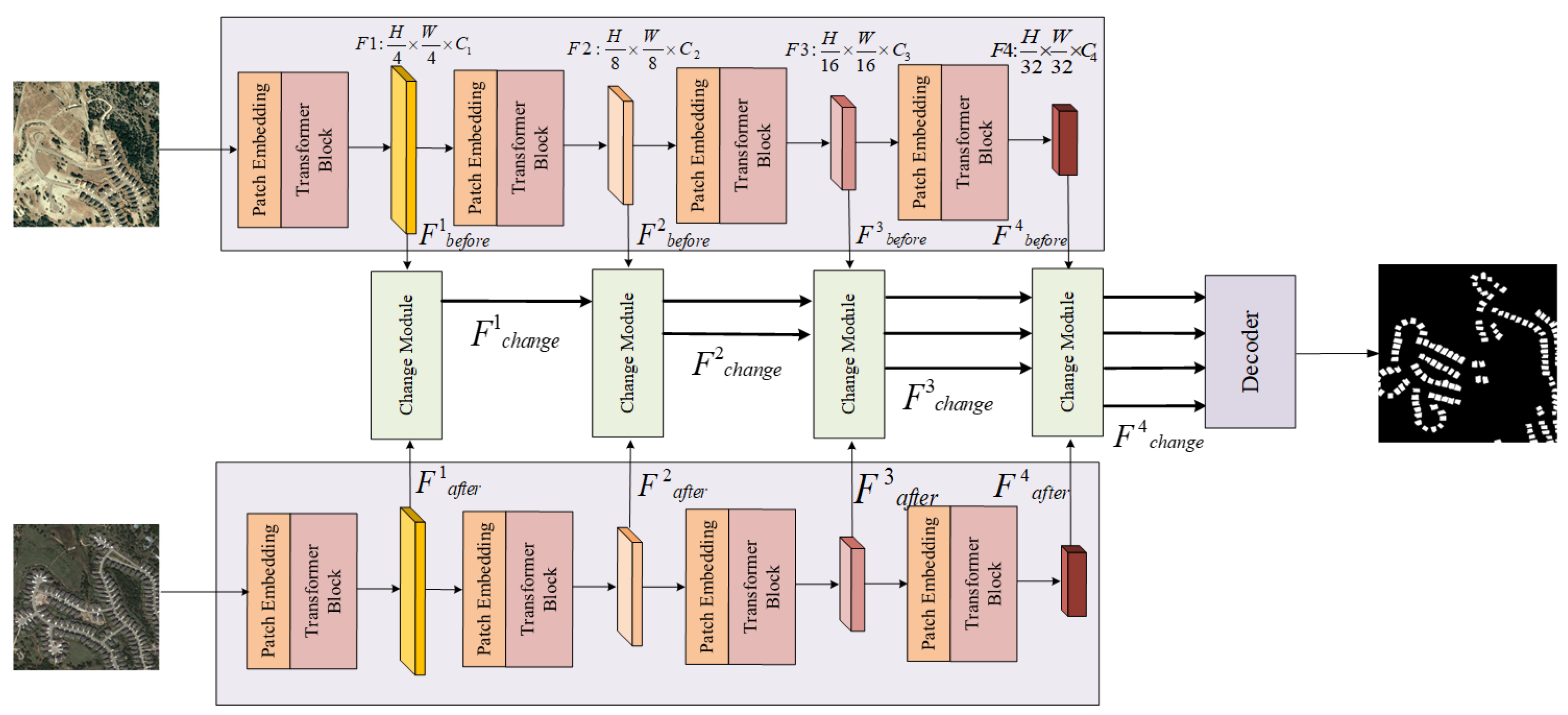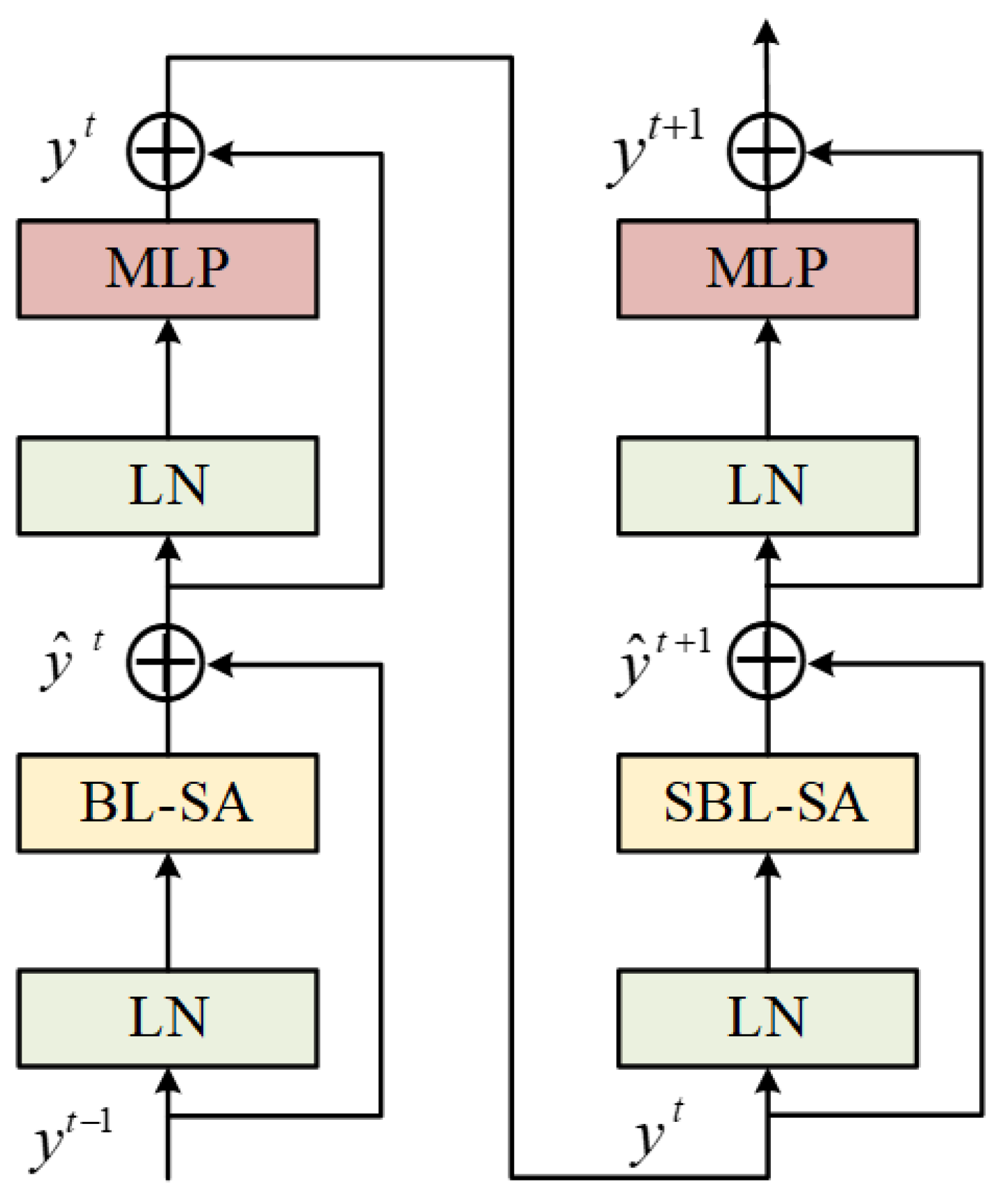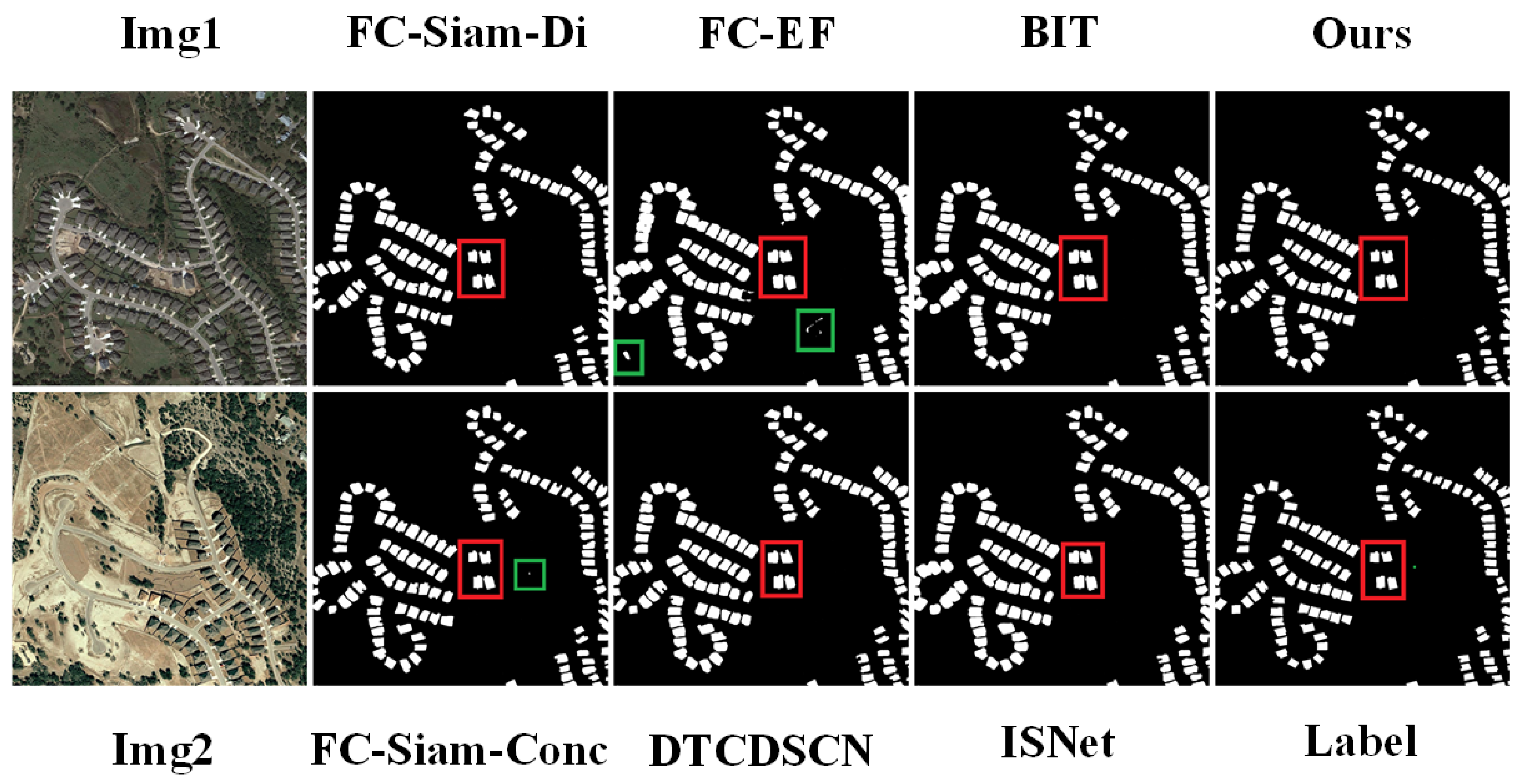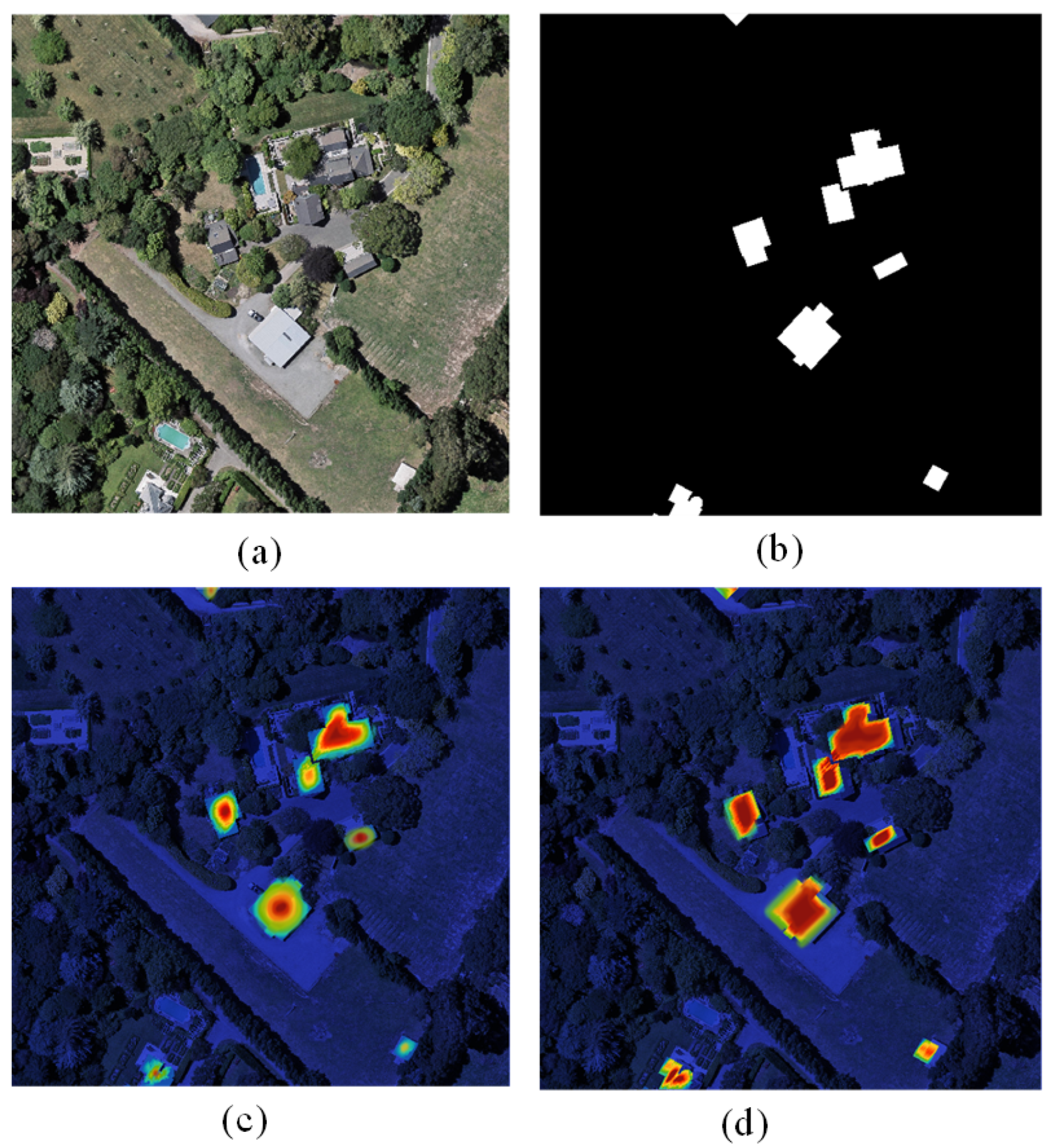Siamese Transformer-Based Building Change Detection in Remote Sensing Images
Abstract
:1. Introduction
- (1)
- A Siamese layered transformer feature extractor is used to better extract multiscale features of buildings in dual-temporal remote sensing images;
- (2)
- A metric-based feature difference module is used to calculate the multiscale feature differences of buildings;
- (3)
- A lightweight decoder is used to fuse multilevel feature differences of buildings and predict whether these buildings have changed in remotely sensed images.
2. Algorithm Design
2.1. Overall Architecture
2.2. Encoder
2.2.1. Patch Merging Block
2.2.2. Siamese-Layered Transformer Block
2.2.3. Difference Module
2.3. Decoder
2.3.1. Feature Fusion
2.3.2. Segmentation Results
3. Experimental Part
3.1. Dataset Introduction
3.2. Experimental Settings
3.3. Evaluation Indicators
3.4. Model Comparison Experiment
3.5. Ablation Experiment
4. Conclusions
Author Contributions
Funding
Institutional Review Board Statement
Informed Consent Statement
Data Availability Statement
Conflicts of Interest
References
- LeCun, Y.; Bengio, Y.; Hinton, G. Deep learning. Nature 2015, 521, 436–444. [Google Scholar] [CrossRef] [PubMed]
- Zhu, X.X.; Tuia, D.; Mou, L.; Xia, G.S.; Zhang, L.; Xu, F.; Fraundorfer, F. Deep learning in remote sensing: A comprehensive review and list of resources. IEEE Geosci. Remote Sens. Mag. 2017, 5, 8–36. [Google Scholar] [CrossRef]
- Chen, H.; Zhang, H.; Chen, K.; Zhou, C.; Chen, S.; Zhou, Z.; Shi, Z. Remote Sensing Image Change Detection towards Continuous Bitemporal Resolution Differences. arXiv 2023, arXiv:2305.14722. [Google Scholar]
- Zhan, Y.; Fu, K.; Yan, M.; Sun, X.; Wang, H.; Qiu, X. Change detection based on deep siamese convolutional network for optical aerial images. IEEE Geosci. Remote Sens. Lett. 2017, 14, 1845–1849. [Google Scholar] [CrossRef]
- Zhang, M.; Xu, G.; Chen, K.; Yan, M.; Sun, X. Triplet-based semantic relation learning for aerial remote sensing image change detection. IEEE Geosci. Remote Sens. Lett. 2018, 16, 266–270. [Google Scholar] [CrossRef]
- Wang, M.; Tan, K.; Jia, X.; Wang, X.; Chen, Y. A deep siamese network with hybrid convolutional feature extraction module for change detection based on multi-sensor remote sensing images. Remote Sens. 2020, 12, 205. [Google Scholar] [CrossRef]
- Mou, L.; Bruzzone, L.; Zhu, X.X. Learning spectral-spatial-temporal features via a recurrent convolutional neural network for change detection in multispectral imagery. IEEE Trans. Geosci. Remote Sens. 2018, 57, 924–935. [Google Scholar] [CrossRef]
- Liu, Y.; Pang, C.; Zhan, Z.; Zhang, X.; Yang, X. Building change detection for remote sensing images using a dual-task constrained deep siamese convolutional network model. IEEE Geosci. Remote Sens. Lett. 2020, 18, 811–815. [Google Scholar] [CrossRef]
- Liu, R.; Cheng, Z.; Zhang, L.; Li, J. Remote sensing image change detection based on information transmission and attention mechanism. IEEE Access 2019, 7, 156349–156359. [Google Scholar] [CrossRef]
- Lyu, H.; Lu, H.; Mou, L. Learning a transferable change rule from a recurrent neural network for land cover change detection. Remote Sens. 2016, 8, 506. [Google Scholar] [CrossRef]
- Li, Y.; Tang, B.; Yi, Y. A novel complexity-based mode feature representation for feature extraction of ship-radiated noise using VMD and slope entropy. Appl. Acoust. 2022, 196, 108899. [Google Scholar] [CrossRef]
- Hong, Z.; Zhong, H.; Pan, H.; Liu, J.; Zhou, R.; Zhang, Y.; Han, Y.; Wang, J.; Yang, S.; Zhong, C. Classification of building damage using a novel convolutional neural network based on post-disaster aerial images. Sensors 2022, 22, 5920. [Google Scholar] [CrossRef]
- Zhao, H.; Shi, J.; Qi, X.; Wang, X.; Jia, J. Pyramid scene parsing network. In Proceedings of the IEEE Conference on Computer Vision and Pattern Recognition, Honolulu, HI, USA, 21–26 July 2017; pp. 2881–2890. [Google Scholar]
- Yang, M.; Yu, K.; Zhang, C.; Li, Z.; Yang, K. Denseaspp for semantic segmentation in street scenes. In Proceedings of the IEEE Conference on Computer Vision and Pattern Recognition, Salt Lake City, UT, USA, 18–23 June 2018; pp. 3684–3692. [Google Scholar]
- Shi, Q.; Liu, M.; Li, S.; Liu, X.; Wang, F.; Zhang, L. A deeply supervised attention metric-based network and an open aerial image dataset for remote sensing change detection. IEEE Trans. Geosci. Remote Sens. 2021, 60, 5604816. [Google Scholar] [CrossRef]
- Chen, L.C.; Papandreou, G.; Kokkinos, I.; Murphy, K.; Yuille, A.L. Deeplab: Semantic image segmentation with deep convolutional nets, atrous convolution, and fully connected crfs. IEEE Trans. Pattern Anal. Mach. Intell. 2017, 40, 834–848. [Google Scholar] [CrossRef]
- Yu, F.; Koltun, V. Multi-scale context aggregation by dilated convolutions. arXiv 2015, arXiv:1511.07122. [Google Scholar]
- Cao, Y.; Xu, J.; Lin, S.; Wei, F.; Hu, H. Gcnet: Non-local networks meet squeeze-excitation networks and beyond. In Proceedings of the IEEE/CVF International Conference on Computer Vision Workshops, Seoul, Republic of Korea, 27–28 October 2019. [Google Scholar]
- Xie, E.; Wang, W.; Wang, W.; Sun, P.; Xu, H.; Liang, D.; Luo, P. Segmenting transparent object in the wild with transformer. arXiv 2021, arXiv:2101.08461. [Google Scholar]
- Vaswani, A.; Shazeer, N.; Parmar, N.; Uszkoreit, J.; Jones, L.; Gomez, A.N.; Kaiser, Ł; Polosukhin, I. Attention is all you need. Adv. Neural Inf. Process. Syst. 2017, 2017, 5998–6008. [Google Scholar]
- Dosovitskiy, A.; Beyer, L.; Kolesnikov, A.; Weissenborn, D.; Zhai, X.; Unterthiner, T.; Dehghani, M.; Minderer, M.; Heigold, G.; Gelly, S.; et al. An image is worth 16 × 16 words: Transformers for image recognition at scale. arXiv 2020, arXiv:2010.11929. [Google Scholar]
- Zheng, S.; Lu, J.; Zhao, H.; Zhu, X.; Luo, Z.; Wang, Y.; Fu, Y.; Feng, J.; Xiang, T.; Torr, P.H.; et al. Rethinking semantic segmentation from a sequence-to-sequence perspective with transformers. In Proceedings of the IEEE/CVF Conference on Computer Vision and Pattern Recognition, Nashville, TN, USA, 20–25 June 2021; pp. 6881–6890. [Google Scholar]
- Deng, J.; Dong, W.; Socher, R.; Li, L.J.; Li, K.; Fei-Fei, L. Imagenet: A large-scale hierarchical image database. In Proceedings of the 2009 IEEE Conference on Computer Vision and Pattern Recognition, Miami, FL, USA, 20–25 June 2009; pp. 248–255. [Google Scholar]
- Chen, H.; Shi, Z. A spatial-temporal attention-based method and a new dataset for remote sensing image change detection. Remote Sens. 2020, 12, 1662. [Google Scholar] [CrossRef]
- Ji, S.; Wei, S.; Lu, M. Fully convolutional networks for multisource building extraction from an open aerial and satellite imagery data set. IEEE Trans. Geosci. Remote Sens. 2018, 57, 574–586. [Google Scholar] [CrossRef]
- Daudt, R.C.; Le Saux, B.; Boulch, A. Fully convolutional siamese networks for change detection. In Proceedings of the 2018 25th IEEE International Conference on Image Processing (ICIP), Athens, Greece, 7–10 October 2018; pp. 4063–4067. [Google Scholar]
- Chen, H.; Qi, Z.; Shi, Z. Remote sensing image change detection with transformers. IEEE Trans. Geosci. Remote Sens. 2021, 60, 1–14. [Google Scholar] [CrossRef]
- Cheng, G.; Wang, G.; Han, J. ISNet: Towards improving separability for remote sensing image change detection. IEEE Trans. Geosci. Remote Sens. 2022, 60, 5623811. [Google Scholar] [CrossRef]
- Fan, Z.; Wang, S.; Pu, X.; Wei, H.; Liu, Y.; Sui, X.; Chen, Q. Fusion-Former: Fusion Features across Transformer and Convolution for Building Change Detection. Electronics 2023, 12, 4823. [Google Scholar] [CrossRef]










| Method | LEVIR-CD | WHU-CD | ||||||||
|---|---|---|---|---|---|---|---|---|---|---|
| Pre. | Rec. | F1 | IoU | OA | Pre. | Rec. | F1 | IoU | OA | |
| FC-Siam-Di | 89.42 | 83.16 | 86.18 | 75.51 | 98.65 | 47.56 | 77.61 | 58.99 | 41.70 | 95.65 |
| FC-Siam-Conc | 91.89 | 76.78 | 83.66 | 71.93 | 98.41 | 60.91 | 73.57 | 66.64 | 49.93 | 97.03 |
| FC-EF | 86.88 | 80.16 | 83.38 | 71.51 | 98.36 | 71.60 | 67.19 | 69.32 | 53.06 | 97.56 |
| DTCDSCN | 88.52 | 86.80 | 87.65 | 78.04 | 98.75 | 63.93 | 82.30 | 71.96 | 56.18 | 97.43 |
| BIT | 89.23 | 89.35 | 89.29 | 80.65 | 98.90 | 86.62 | 81.47 | 83.98 | 72.38 | 98.75 |
| ISNet | 91.37 | 87.86 | 89.58 | 80.68 | 98.89 | 84.83 | 81.71 | 83.24 | 72.47 | 98.38 |
| Fusion-Former * | 90.30 | 88.78 | 89.53 | 81.05 | - | 86.40 | 86.72 | 86.00 | 72.86 | - |
| Ours | 89.99 | 89.18 | 89.58 | 80.69 | 98.98 | 86.71 | 81.92 | 84.51 | 72.87 | 98.86 |
| Method | Pre. | Rec. | F1 | IoU | OA |
|---|---|---|---|---|---|
| Our | 89.9 | 89.1 | 89.5 | 80.6 | 98.9 |
| Base | 78.8 | 82.8 | 80.8 | 71.6 | 96.4 |
| Base+Siamese-Transformer | 84.6 | 84.6 | 84.6 | 75.2 | 98.1 |
| Base+Siamese-Transformer+ DiffModule | 87.6 | 87.3 | 87.4 | 79.3 | 98.6 |
| Method | Pre. | Rec. | F1 | IoU | OA |
|---|---|---|---|---|---|
| Our | 86.7 | 81.9 | 84.5 | 72.8 | 98.8 |
| Base | 73.1 | 71.8 | 72.4 | 60.3 | 94.5 |
| Base+Siamese-Transformer | 83.3 | 79.9 | 81.6 | 68.6 | 97.5 |
| Base+Siamese-Transformer+ DiffModule | 85.6 | 81.3 | 83.3 | 71.5 | 97.9 |
Disclaimer/Publisher’s Note: The statements, opinions and data contained in all publications are solely those of the individual author(s) and contributor(s) and not of MDPI and/or the editor(s). MDPI and/or the editor(s) disclaim responsibility for any injury to people or property resulting from any ideas, methods, instructions or products referred to in the content. |
© 2024 by the authors. Licensee MDPI, Basel, Switzerland. This article is an open access article distributed under the terms and conditions of the Creative Commons Attribution (CC BY) license (https://creativecommons.org/licenses/by/4.0/).
Share and Cite
Xiong, J.; Liu, F.; Wang, X.; Yang, C. Siamese Transformer-Based Building Change Detection in Remote Sensing Images. Sensors 2024, 24, 1268. https://doi.org/10.3390/s24041268
Xiong J, Liu F, Wang X, Yang C. Siamese Transformer-Based Building Change Detection in Remote Sensing Images. Sensors. 2024; 24(4):1268. https://doi.org/10.3390/s24041268
Chicago/Turabian StyleXiong, Jiawei, Feng Liu, Xingyuan Wang, and Chaozhong Yang. 2024. "Siamese Transformer-Based Building Change Detection in Remote Sensing Images" Sensors 24, no. 4: 1268. https://doi.org/10.3390/s24041268





